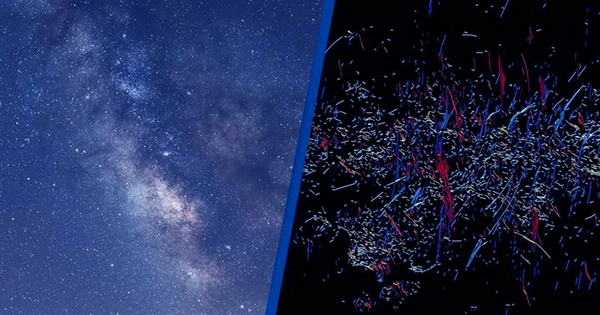A multinational team of astrophysicists has uncovered something completely new in the Milky Way galaxy’s core.
Farhad Yusef-Zadeh of Northwestern University discovered huge, one-dimensional filaments dangling vertically around Sagittarius A*, our galaxy’s center supermassive black hole, in the early 1980s. Yusef-Zadeh and his colleagues have identified a new population of filaments, but these threads are much shorter and lie horizontally or radially, extending out from the black hole like spokes on a wheel.
Although the two filament populations share many features, Yusef-Zadeh believes they originated in distinct places. While the vertical filaments span the galaxy, soaring up to 150 light-years in height, the horizontal filaments resemble Morse code dots and dashes, punctuating only one side of Sagittarius A*.
The study will be published in The Astrophysical Journal Letters on Friday, June 2nd.
“It was unexpected to find a new population of structures pointing in the direction of the black hole,” Yusef-Zadeh added. “I was truly taken aback when I saw these. We had to put in a lot of effort to prove that we weren’t delusory. And we discovered that these filaments are not random but appear to be linked to our black hole’s outflow. We could learn more about the black hole’s spin and accretion disk orientation by analyzing them. It’s wonderful to discover order in the midst of our galaxy’s tumultuous nucleus.”
Yusef-Zadeh is a member of CIERA and a professor of physics and astronomy at Northwestern’s Weinberg College of Arts and Sciences.
Decades in the making: The unexpected discovery may come as a surprise, but Yusef-Zadeh is no stranger to solving puzzles at the heart of our galaxy, which is roughly 25,000 light-years away from Earth. His most recent study relies on four decades of research. Yusef-Zadeh, together with Ian Heywood and their partners, discovered two massive radio-emitting bubbles around Sagittarius A* after discovering the vertical filaments with Mark Morris and Don Chance in 1984. Then, in a series of papers published in 2022, Yusef-Zadeh (in collaboration with Heywood, Richard Arent, and Mark Wardle) discovered approximately 1,000 vertical filaments that formed in pairs and clusters, often piled equally spaced or side by side like harp strings.
Yusef-Zadeh attributes the rush of new findings to improved radio astronomy technology, specifically the MeerKAT telescope at the South African Radio Astronomy Observatory (SARAO). Yusef-Zadeh’s team employed a technique to remove background and smooth noise from MeerKAT photos in order to isolate the filaments from surrounding structures in order to localize the filaments.
“The new MeerKAT observations have been a game changer,” he explained. “Technology advancement and dedicated observation time have provided us with new information.” It’s a true technological accomplishment by radio astronomers.”
Vertical vs. horizontal: Yusef-Zadeh was astounded to discover horizontal counterparts to the vertical strands, which he estimates are roughly 6 million years old. “We’ve always been interested in vertical filaments and their origin,” he explained. “I’m used to seeing them vertically. I never considered that there could be others on the plane.”
While both populations are made up of one-dimensional filaments that may be seen with radio waves and appear to be linked to galactic center activity, the similarities end there.
Vertical filaments are perpendicular to the galactic plane; horizontal filaments are parallel to the plane but point radially toward the galaxy’s core, where the black hole is located. Vertical filaments appear to release magnetic and relativistic radiation, whereas horizontal filaments appear to emit heat radiation. The vertical filaments appear to accelerate particles moving at near-light speeds, while the horizontal filaments appear to accelerate hot material in a molecular cloud.
There are hundreds of vertical filaments but only a few hundred horizontal filaments. Vertical filaments, which can be up to 150 light-years tall, significantly outnumber horizontal filaments, which are just 5 to 10 light-years long. Vertical strands ornament the area around the galaxy’s nucleus, while horizontal filaments appear to radiate out to only one side, pointing toward the black hole.
“One of the most important implications of radial outflow that we have detected is the orientation of the accretion disk and jet-driven outflow from Sagittarius A* along the galactic plane,” Yusef-Zadeh explained.
‘Our work is never complete’: The new discovery is riddled with mystery, and Yusef-Zadeh’s work to solve them has only just begun. For the time being, he can only explore a feasible explanation for the mechanisms and origins of the new population.
“We think they must have originated with some kind of outflow from an activity that happened a few million years ago,” Yusef-Zadeh explained. “It appears to be the result of that outflowing material interacting with objects nearby.” Our task is never finished. We must constantly make new observations, test our notions, and tighten our analyses.”
















